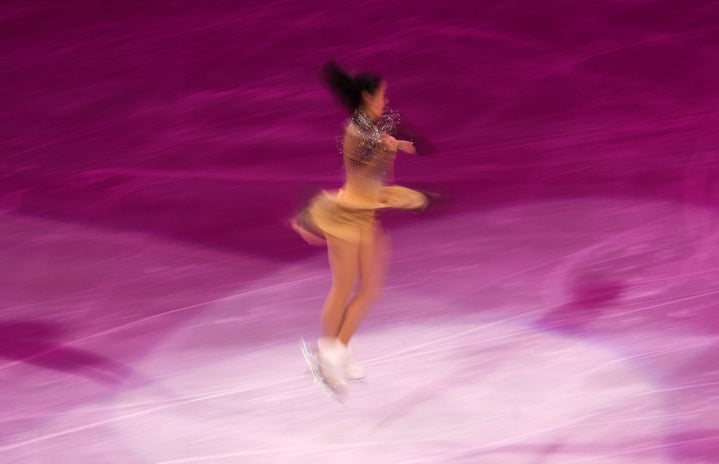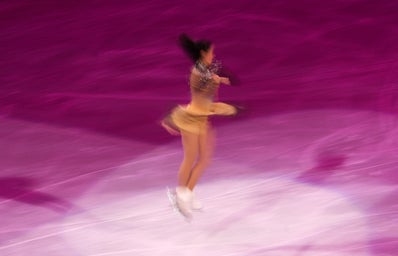Figure skating has remained one of the pinnacle events of the Winter Olympic Games known for its combination of athleticism and artistic expression. While individual skating, pairs skating and ice dance have each stood out for a combination of intricate elements, one aspect of the sport has undergone a massive transformation in the development of artistry and athletic composition: ladies’ figure skating. The sport continues to evolve, with skaters performing elite tricks and harder jumps as the years go by. In particular, ladies’ figure skating has undergone a complete revolution in terms of the difficulty of elements performed in a program.
The triple axel, a jump where a skater performs 3.5 revolutions in mid-air without toe pick assistance, has primarily been a jump performed in the men’s competition. It was one of the first jumps women began attempting after Midori Ito landed the first one in competition in 1988. In the 40 years since, more and more ladies, particularly under the age of 20, have begun performing this element in both their short and free programs. Ladies’ figure skating has also undergone a movement known as the “quad revolution.” The quad jump involves a skater rotating 4 times mid-air before landing backward on one foot, a feat that only the top men in the world attempt to complete. Many never thought women would attempt the difficult quad jumps until 2018 when Russian juniors entering the senior level of skating began dominating international competitions by performing the jump.
Both quad jumps and the triple axel have become increasingly popular amongst young female figure skaters, particularly with the Russians, who have been dominating competitions with their technical abilities since 2014. Since 2014, when 15-year-old Yulia Lipnitskaya and 17-year-old Adelina Sotnikova reigned over the 2014 Sochi Winter Olympic Games, Russian ladies have entered a period of dominance within the sport. Russian female figure skaters have continuously made the podium at the top competitions, including the Olympics, where the past 3 champions have been Russian, and the European Championships, where every champion has been a Russian girl since 2014. Leading Russia’s dominance has been their younger skaters all under the age of 18, who have been performing quad after quad at the senior and junior levels since 2018.
As the Russians are leading the quad revolution in ladies’ figure skating, young figure skaters need to have at least one quad under their belt in order to stand any chance of competing at Russian Nationals, where most girls are already attempting 2-3 quad jumps. However, because of the difficulty that is involved with the jump, it puts extreme physical and mental pressure on the skaters who have often undergone extreme pain and intense physical training to perform. The stress of impending injuries and harmful accidents has become common among young female skaters, who have become the revolutionaries in achieving high levels of athleticism at the risk of their own personal health and causing irreversible damage.
Many of these young skaters have come from the tutelage of Eteri Tutberidze, who has constantly been scrutinized for her harsh methods and strict control over her skaters. Tutberidze has coached many of the top Russian skaters, including 2014 Olympic gold medalist Yulia Lipnitskaya, 2018 Olympic gold medalist Alina Zagitova and 2018 Olympic silver medalist Evgenia Medvedeva. Her latest skating prodigies include 17-year-old Anna Shcherbakova, the 2022 Olympic gold medalist and defending World Champion; 17-year-old Alexandra Trusova, the 2022 Olympic silver medalist and quad queen; and 15-year-old Kamila Valieva, 2022 Olympic gold medalist and the current record holder in the short and free program. She has managed to unlock the key to performing multiple quads in one program and has trained all of her young skaters since the age of 11 to perform them. However, Tutberidze’s methods do not come without consequence. She has pushed her skaters to train quads by controlling their diets and weight rather than introducing proper techniques. She has been known to weigh her skaters multiple times a day in order to ensure they remain skinnier to get more speed and rotational ability to perform quads. Her harsh training regimens include constantly running through program after program and jump after jump for multiple hours a day until skaters complete their programs cleanly from muscle memory.
Tutberidze’s methods have seen many of her skaters burn out of competitions before reaching the age of 20 due to the severe regimens and training she puts her girls through beginning at the age of 11. Her skating rink, Sambo 70, has been compared to a factory that — since 2014 — has produced more and more younger skaters under the age of 18 that reign over the ladies competition for one or two years before being replaced by their younger, better rink mates or retiring due to burnout, injury or worse. Yulia Lipnitskaya was forced to retire at the age of 19 due to her debilitating battle with anorexia. She was replaced by Evgenia Medvedeva, who retired at the age of 20 with a broken back. Alina Zagitova emerged as the new Tutberidze hopeful but soon withdrew from the sport at the age of 17 to focus on herself and her health. She was then replaced with the graduating class of 2018 quad jumping juniors, who will continue to be replaced by Tutberidze’s younger class as the cycle continues on and on. Tutberidze’s harmful coaching and training methods have ruined the careers of young girls before they reach adulthood, risking her athlete’s health and happiness for record-breaking performances and gold medals.
While her girls achieve heights above and beyond what was thought possible in sports, her methods are detrimental to her athletes’ well-being, sacrificing their longevity and mental health at such tender ages. This was all the more obvious during the drama of the ladies’ event during the 2022 Winter Olympic Games when Kamila Valieva tested positive for a banned heart drug: trimetazidine. The ensuing controversy saw her banned and unbanned from the competition, where she completely fell apart in her free program on the biggest stage in the sport after succumbing to the pressures and mental health from the scandal. The adults surrounding her failed to protect her from controversy and physical harm for the sake of gold as the world watched her breakdown and suffer as a consequence. Anna Shcherbakova was seen sitting alone without emotion after her win while Alexandra Trusova broke down into angry tears, crying about her hate for the sport after placing second. The devastating scenes created the perfect picture of the culmination of Tutberidze’s methods and manipulation of her young skaters on the world’s biggest stage as all three girls left Olympic ice in tears.
The scenes seen at the Olympics revealed the consequences of the revolution ladies’ figure skating has undergone. The frustrated tears, the pressure, and the physical pain were made abundantly clear as the Russian girls took the ice, painting a darker picture of what went on behind their success. While many had been praising Russian skaters for their technical advancements of the sport, many now do so haltingly after witnessing the controversy at the Olympics. They have become nothing more than disposable toys, manipulated and abused to reach unachievable heights beyond other skaters to fulfill the dreams of their country. Yes, Russian teenagers have transformed the sport of figure skating, but at what cost?



